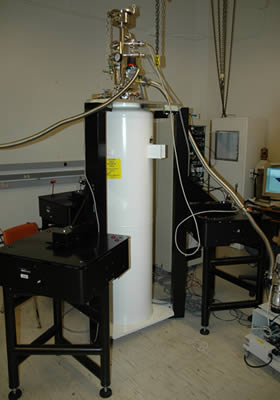Cryostat Vibration Isolation
Cryostats Getting to cryogenic temperatures can be done in a few ways. Cryostats are one way that many people use to get to the low temperatures needed for whatever application is present. Cryostats use a cryogen (a liquid with a normal boiling point below -240°F (-150°C) that slowly evaporates and maintains the low temperature. This is not always ideal, but it is sometimes the best solution for the application.
Cryostats often contain very sensitive instrumentation. They come in many different shapes, sizes and weights. Whether you are doing low temperature AFM, NMR or something else, we have several options available.
Pulse tube coolers use a special circulation cycle that allows for a closed loop system that removes the need to re-fill cryogenic fluid, as there is no boil off. These coolers can have very low frequency at the cold tip. (As low as 1 Hz) Using a very low stiffness thermal strap in conjunction with 0.5 Hz isolation, can help minimize the transmission of the noise.
Another way of cooling is Adiabatic Demagnetization Refrigeration (ADR). Very simply, this also uses a closed system and uses properly timed magnetization and demagnetization to cool a special cooling fluid to cryogenic temperatures for a limited time. The fluid has the property that when a magnetic field is removed, the temperature drops. These can also run continuously by using two coolers working together. This way, cryogenic temperatures can be maintained for applications that need cryogenic temperatures long term.
Most applications that call for the use of one these types of cooling schemes are quite sensitive. Quantum computing, low temperature AFM, etc. all need the best isolation possible.
If your lab is on an upper floor of a building, air isolators may not be able to provide you enough isolation to get rid of building modes. In the worst case, the building might have a low resonant frequency close to that of the air table’s. If this is the case, you can have amplification of the buildings vibrations. Obviously, this is not ideal. Our 1/2 Hz isolators will isolate at these low frequencies and will give your cryostat the best possible vibration isolation.
Minus K Technology isolators are ideal for this as they are easily to integrate into new and existing designs, as there are many capacities and form factors available. Our isolators can be mounted on a set of pedestals as shown in the image to optimize our interface.
Of course, your cryostat may not have mounting brackets such as these shown. We can work with you to determine the best way to incorporate our isolators into your system. Minus K can design bracketry for you, or work with you and advise on the best way to build and incorporate them.
*Acronyms for Cryotats:
- ADR: Adiabatic Demagnetization Refrigeration
- PTR: Pulse Tube Refrigerator or Pulse Tube Cryocoolers
 |
 |
|
Sample Cryostat on three Minus K CM-1s & pedestals |
Arizona State Cryostat on three Minus K BM-1s
|
|
 |
 |
|
kiutra S-Type Optical Teaser intergrated with 2 Minus K CM-1 isolators |
Two Minus K CM-1 isolators supporting Kiutra Adiabatic Demagnetization Refrigeration (ADR) in the S-Type Optical Teaser |